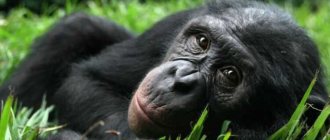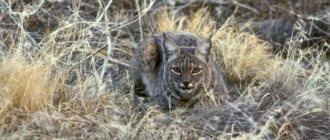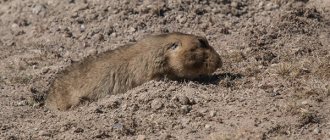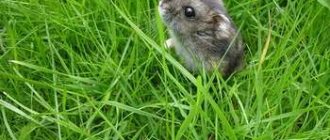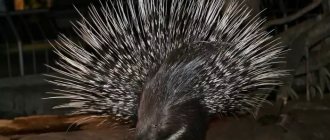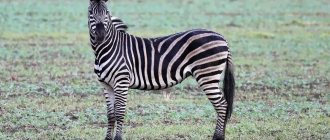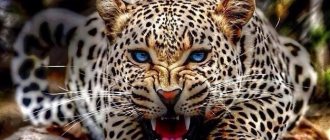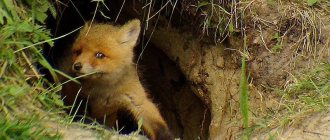- Food conditions
When getting a pet of the hamster family, owners do not realize that in the wild the animals are a serious adversary to other inhabitants of their range. Rodents can survive in rather harsh conditions, taking into account the peculiarities of the organization of life. Naturally, living in a house or apartment, a hamster requires special attention and additional care; its body is not accustomed to external conditions, however, being in survival conditions, the baby is able to take care of the sponsored territory.
In which zone does a hamster most often live?
The first ancestor of the animal was discovered by the scientist Waterhouse in 1839, who subsequently made an accurate scientific description of this family. The animals are native to Syria .
Today it is known that the animals live in the countries of Europe, Asia, Siberia, Iran, Syria, America and Africa. Zoologists continue to study this amazing subfamily, and have told the world many interesting facts. Here are some of them:
- hamsters prefer dry climates, steppe and forest-steppe zones;
- found in desert, semi-desert, dense forests;
- some species have adapted to the altitude and create families on rocky terrain up to 3.5 thousand meters above sea level;
- Agricultural fields and summer cottages have become the animals’ favorite places;
- the harsh and cold climate of Siberia, the Far East, and Northern China is not a hindrance to these animals;
- hamsters densely populated the arid and hot deserts and semi-deserts of southern Africa.
Wild animals dig long, deep holes that allow them to survive extreme cold and unbearable heat. The area of residence depends on the type of hamster. An attentive hamster chooses only a safe and cozy place where he can calmly breed and live a long, amazing life.
Is it a protected animal?
In recent years, the hamster population has declined sharply. Scientists attribute this to a decrease in female fertility. Previously, the litter consisted of 10-12 cubs. Now their number has decreased to 3-6 individuals. This is due to the active use of pesticides by humans in agriculture.
Until the middle of the 20th century. In Europe and the USSR, animals were hunted for their fur. Massive fishing and the active use of pesticides in agriculture have also led to a reduction in the number of rodents.
In some European countries, the wild hamster is on the verge of extinction. In France, Belgium, Poland, and Germany, rodents are protected. Measures are being taken to restore the animal population. A decrease in the number of rodents has been recorded in Russia. In 5 constituent entities of the Russian Federation, the hamster received conservation status. Animals are protected in Tatarstan, Tambov, Nizhny Novgorod, Penza and Lipetsk regions.
In some countries the hamster is on the verge of extinction.
The most common types of hamsters in nature
Hamsters exist in nature in 19 species. The territory of the Russian Federation includes 12 varieties, which are divided into 6 groups. Here are three groups consisting of the most prominent representatives:
- real. The rodents are distinguished by their yellow-brown color, weighing 500 g. The sides are white, the ears are small, the paws resemble human hands;
- hairy legs. The animals have a sandy-golden color and weigh about 30 g. The muzzle and abdomen have small white spots. The ears are large and stand upright;
- rat-like. Gray-brown animals reaching a weight of 240 g. The belly is white, and the tail resembles a rat in appearance.
Males are smaller in size than females. They are naturally endowed with four sharp teeth that help chew hard objects. The teeth have no roots and grow throughout the hamster's life.
Common, Syrian and Djungarian representatives of the hamster family are considered interesting creatures. Each animal is unique and differs in its habitat and way of life.
Common hamster
The rodent grows up to 30 cm, and the tail - up to 5 cm. The tail is thick, densely covered with hair. Nature has endowed the hamster with a bright, three-color color. The fur on the body has light spots. The color of the fur helps the animal camouflage itself with the surrounding nature. The common hamster lives:
- in European countries;
- in the European part of Russia;
- in the Urals and Siberia;
- in the mountainous areas of the Caucasus and Altai.
This species prefers to settle near human dwellings, agricultural buildings, or chooses a forest area. Digs deep holes with many exits. Excellent climber on tree trunks when looking for food.
Favorite food is grain crops growing in the fields. Neighborhood with people helps the common hamster survive in difficult times of the year. He raids barns where vegetables, wheat, and livestock feed are stored.
Outbuildings with cows, poultry, and pigs are filled with fresh food. The hamster collects supplies and hides them in his pantry. People very often came across hamster holes near their summer cottages. Fresh roots and greens are always available, and the little animal is well-fed.
Syrian hamster
The rodent grows up to 14 cm, and its tail - up to 15 mm. The coat is thick, golden or red-brown. The belly is light. Lives in Syria and Turkey. The fur coat helps to camouflage into sandy areas and not fall into the clutches of predators.
Lives in burrows. If the temperature drops to -4 degrees, the hamster falls into stupor. The diet consists of seeds, grain crops, ants, wasp larvae and flies.
Important! Syrian, Djungarian and some species of wild hamsters are popular as pets.
Djungarian hamster
The animal grows up to 10 cm, and its tail - up to 18 mm. The fur coat is colored brown and gray. The belly is white, and light colors occupy most of the body. A black or dark brown stripe runs along the ridge. The further east a hamster is found, the smaller it is in size and lighter in color.
Lives in Western Siberia, the Republic of Khakassia, Northern Kazakhstan. Lives in a burrow with two or three winter chambers, where it stores food supplies. The diet consists of plant foods, insects and larvae.
When winter approaches, the rodent accumulates a significant amount of subcutaneous fat. Winter in the northern regions is harsh, and the temperature often drops to -50 degrees. The fat layer helps the animal survive safely until warmer weather.
The main enemies of the Djungarian hamster are birds of prey, land animals and domestic animals. Hawk, owl, wolf, and fox inhabit the entire taiga and swamp areas. The hamster lies in wait everywhere, at any time of the day. At night, the dwarf is attacked by an owl, so often the animal does not live to be one year old.
Have you ever come across a wild hamster?
Are there fundamental differences between wild and domesticated individuals?
Domestic and wild rodents have similar body structures, but the animals differ greatly in size. Karbysh is much larger and heavier. The ears of wild species are more massive and clearly visible on the head. The color of the animals is also different; pets often have a beige, golden or white coat. In wild relatives, the body is covered with brown fur with large black and light spots.
The nature of the animals also varies greatly. Pets are calm, peaceful animals. They get used to the presence of a person and allow themselves to be picked up.
Wild individuals are unpredictable and aggressive. They do not tolerate proximity to other animals. A field hamster can bite a person; picking it up is dangerous. This is a wild animal that is very difficult to tame.
Living conditions in nature
Hamsters live on the ground. Cheek pouches help them swim across small bodies of water. They easily travel long distances in search of food or to create new homes. Here are a few facts that will help you understand the hamster's lifestyle:
- lives alone. The male and female spend a short time together during mating;
- stores a decent amount of food. Food allows him to survive winter and adverse weather conditions;
- falls into torpor or short-term hibernation when cold weather sets in. The animal is not prone to full winter sleep;
- active at night. This is how the rodent avoids attacks from terrestrial predators and birds;
- eats plant foods. They are not squeamish about eating insects and carrion. Large species prey on small animals;
- cautious and cowardly. The hamster's self-preservation instinct is well developed;
- protects his house from his relatives. If a fellow encroaches on the hamster's territory, a fierce battle begins. The defeated individual flees;
- females are good mothers , protecting their offspring until adulthood.
Attention! An interesting fact remains that Chinese peasants try to find a hamster pantry during lean times. People get from 10 to 20 kg of grain from one hole. The thrifty rodent has helped more than one family survive.
Nature has endowed hamsters with good hearing and the ability to make unusual sounds. Such features help the animals protect themselves from predators. Sharp teeth allow you to protect your territory from attacks by birds of prey and other rodents.
Important! Wild hamsters are carriers of dangerous viral and infectious diseases. Often people became victims of rabies and plague.
Lifespan
Wild animals have a life expectancy of 2 to 6 years, which distinguishes them from domestic pets. Some individuals can live up to 10 years. The period of existence depends on the amount of food stored and predators. Therefore, some individuals do not survive to one year of age. If the female does not have time to take her offspring to a safe place, then the entire family dies.
There are species that are on the verge of extinction. This is the Syrian and Newton's hamster. They are listed in the Red Book and live under supervision. Zoologists and scientists do not release them into the wild.
Nutrition
Hamsters are omnivorous animals, but they highly value vegetation. In summer they eat roots, greens, seeds, and insects. Large species of this family feed on small mice, lizards, and amphibians. In winter they eat reserves of grains, seeds, and vegetables. One individual is capable of accumulating up to 20 kg of food in the pantry. There were hamster “barns” where food supplies reached 90 kg.
Reproduction
The hamster reaches sexual maturity at two months of age. The male attracts the female with characteristic sounds. After the female has accepted courtship, the pair retires to a hole. Mating lasts from 20 to 24 hours. Then the female individual leaves the partner and bears the babies. After 17-20 days, offspring appear. Babies are born naked and blind.
One litter consists of 5-8 small hamsters. It is not uncommon for one baby or 18 tiny individuals to be born. Babies grow quickly. After a week, the body is covered with fluff, and after another 3 days it is covered with a full fur coat. The eyes open on day 14, and the hamsters begin to explore the world around them. During this period, they already become full-fledged, independent individuals. The instinct of self-preservation manifests itself, and they safely leave their native nest.
Only the mother ensures the safety of the children. If the adult feels danger, she moves the babies to a safer place. Transports them in cheek pouches.
The warm season allows one mother to bring 2 or 3 litters . Zoologists claim that there have been cases of babies being born in winter. The cubs of the first litter give birth to their offspring by the end of summer.
Survival Features
Having found out in what places in nature hamsters live, interest naturally arises regarding their nutrition and reproduction. Given their small size, it is quite difficult for them to find food for themselves without becoming a victim of animals that are large in size.
Food conditions
It is a mistake to believe that small animals eat green grass. They also need young shoots of plants, greens, tubers, seeds, and even small insects. Rodents usually hunt at night in the same place where they live. They can go long distances from their burrows to search for food if there is insufficient amount of pasture.
Breeding conditions
Males look for females ready for reproduction by the smell secreted by special glands. The mating season begins in late April and lasts until mid-October. Pregnancy of females of this family can last from 15 to 22 days, then up to 18 babies are born. After fertilizing the female, the male leaves her and does not take part in raising the offspring.
Baby wild hamsters are blind and have virtually no fur. They feed mainly on mother's milk, and on the twelfth day they begin to absorb reserves of greenery collected by the female during the summer. Starting from the twenty-first day of life, hamsters become independent individuals and leave the “mother’s” house. They begin to look for food on their own and choose an area where they can dig their own burrow.
Peppermint treat
Ingredients:
- 1 medium overripe banana.
- 2 chicken eggs.
- 3 tbsp. spoons of honey.
- 3 tbsp. tablespoons of liquid coconut oil (can be replaced with sunflower oil in the same amount).
- 1/2 teaspoon mint flavoring.
- 1/2 teaspoon baking powder.
- A quarter cup of carob (roasted carob powder). A small amount of cocoa can be substituted, but this is not recommended for animals. Therefore, try to find an original product.
- Oat flour.
Cooking procedure.
1. Mash the banana in a bowl.
2. Beat eggs into the resulting mass, add honey, baking powder, cinnamon and coconut (sunflower) oil.
3. Add oatmeal to the mixture to form a firm but slightly moist dough.
4. Divide the resulting volume into 2 equal parts.
5. Pour 1/4 cup of carob powder into one half, and add the same amount of flour to the second half. A hard lump should form that does not stick to your hands.
6. Roll out 2 rectangles, 9-10 mm thick.
7. Place the layers of dough on top of each other and roll along the long side. Wrap the resulting sausage in plastic wrap and put it in the refrigerator overnight.
8. Preheat the oven to 180 degrees.
9. Cover a baking sheet with parchment paper.
10. Remove the film and cut into 3-3.5 cm rounds.
11. Place on a baking sheet. During cooking, portions of dough will not increase in volume, so you can place them close to each other.
12. Bake for 10-15 minutes.
If you want to please your pet with a crunchier treat, cut the rolls into thin slices (about 1 cm), and after cooking, additionally dry them in a warm oven or even in a non-stick frying pan.
The finished product is stored for a long time in a dry place. So, by baking peppermint rolls once, you can treat your four-legged pupil with them for a long time.
Bon appetit to your dog!
I like it I don't like it
Suitable home
Due to the fact that it is not recommended to walk the dzhungarika around the apartment, it needs a large and spacious cage. There should be enough space for walking and playing. There are several options for houses for dwarf rodents.
Cell
| Pros: | Minuses: |
|
|
Labyrinths
Houses with several compartments and passages between them resemble burrows. Mazes are usually more expensive than cages and aquariums, but they can be built gradually. Buy the main compartment first and then the top "room" and join them together.
Please note that for dwarf hamsters it is necessary that the compartments be connected by ladders. Toddlers can't climb up tunnels
If you decide to assemble such a house yourself from scrap materials, do not forget to make slits in the walls and ceiling. They will provide a constant flow of fresh air.
Aquarium house
Special plastic aquariums for rodents are great for dwarfs. Their small size allows them to make do with one-story dwellings. The main thing is that all the necessary accessories are there.
Where to put the cage?
Rodents feel good at the same air temperature as people. Do not place the cage in drafts or on a sunny windowsill. In addition, you should keep the cage away from:
- working battery;
- places with high humidity;
- TV;
- audio systems;
- other animals.
Do not place the house on the balcony (temperature changes, sun), in a draft (risk of colds), in the kitchen (not hygienic) and in the bedroom (rodents are active at night and make noise).
Cage equipment
What else will you need? The animal definitely needs:
- drinking bowl;
- Bowl;
- chalk stones or branches;
- nest (house);
- wheel;
- toys.
The ideal drinking bowl is the so-called dropper bottle. It needs to be hung away from the nest so that accidental drops do not wet it. Don't forget to change the water every day. Fresh water is the key to animal health.
It is better to place food in a heavy clay bowl so that the animal cannot turn it over. A hanging metal bowl will also work.
Chalk stones or branches are needed to point the teeth. Rodents' teeth grow throughout their lives, and if they are not taken care of, serious problems will begin.
In their natural habitat, rodents sleep in a separate compartment of their burrow. Try to create maximum comfort for him at home with the help of a small nest. Small wooden or plastic houses are suitable for this.
The wheel will help your pet get enough physical activity. Buy a solid wheel without slots or protrusions to protect the feet from fractures. Attach the wheel almost flush to the wall, otherwise the hamster may crawl between them and get stuck.
There are many toys for rodents at pet stores, but you can make many of them yourself. Excellent holes are made from cardboard toilet paper cylinders. Plastic rolling toys can successfully replace whole walnuts or hazelnuts. You shouldn’t fill the entire cage with toys – 1-2 is enough.
This is interesting: What running speed does a hyena develop?
Interface used
Another type of classification is the interface used to connect the manipulator to the computer.
There are three types of mice:
PS/2.
They are connected via a round five-pin plug into the corresponding socket on the motherboard (usually marked green). The disadvantage is that after reconnecting the device, the computer does not respond to it, so a restart of the operating system is required.
USB.
A more advanced interface that allows you to change the mouse on the go or use several mice at the same time.
Wireless.
Through the air it communicates with a special transmitter connected via the USB port of the computer. Without this transmitter they do not work. The main disadvantages are the possibility of signal interception by attackers and batteries running out at the most inopportune moment.
In all other respects, the types of wireless mice do not differ from regular ones.
Lifestyle
These animals are most ; during the day they hide in a hole. In winter, it hibernates, but not deeply, and periodically wakes up to eat from its reserves.
Comes out in March - April. Males are friendly only to females during the breeding season, the rest of the time they are aggressive towards everyone, including humans .
The size of the enemy is not important for a hamster . They have a solitary lifestyle and protect their territory. They attack “unwanted guests.”
How can you get infected from a wild hamster bite?
Wild rodents are natural carriers of many diseases. The bite of the animal is dangerous for humans and domestic animals. The rodent's teeth are sharp and leave deep, poorly healing wounds. The saliva of animals contains pathogens of about 30 diseases.
Fleas live in fur and carry salmonella, tularemia, brucella and other infections.
If you are bitten by a wild hamster, you should rinse the wound thoroughly with running water. Then treat the skin with disinfectants - hydrogen peroxide or iodine. Sometimes after a bite the victim’s body temperature rises. To avoid serious consequences, it is recommended to seek qualified help at a medical center or hospital as soon as possible.
Enemies
Like any animal in the wild, the hamster has its enemies. Although the rodent is not large and it is not possible for it to repel large predators, despite this, predators cannot destroy hamsters as a species, they only keep the number of these animals at a not too large level. Among the predators that feed on hamsters are the following:
- terrestrial predators such as wolf, fox, lynx, which can wait and chase hamsters;
- birds of prey - in the daytime they hunt hamsters of the hawk family, but at night owls pose a danger to hamsters;
- pets such as cats and large breeds of dogs that may attack the hamster in suburban and urban areas.
For both wild and domestic hamsters, cats and dogs pose a serious danger. They can attack and eat a rodent, so the cage with the hamster must be kept out of the reach of the cat and dog.
